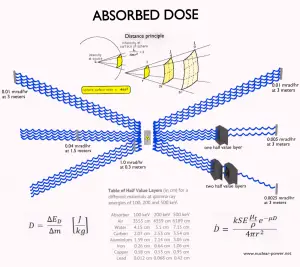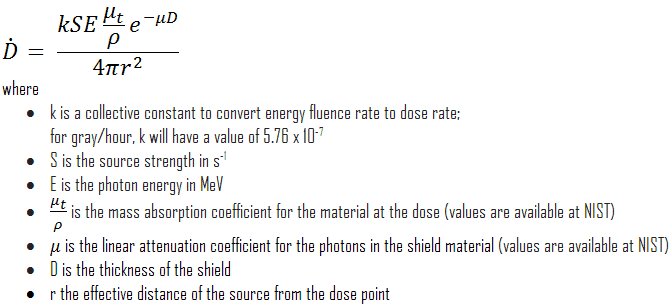RAD – Unit of Absorbed Dose
 A dose of one rad is equivalent to the deposition of one hundred ergs of energy in one gram of any material. Note that, the erg is a unit of energy and work equal to 10−7 joules. A related unit, the roentgen, is used to quantify the radiation exposure. The F-factor can be used to convert between rads and roentgens.
A dose of one rad is equivalent to the deposition of one hundred ergs of energy in one gram of any material. Note that, the erg is a unit of energy and work equal to 10−7 joules. A related unit, the roentgen, is used to quantify the radiation exposure. The F-factor can be used to convert between rads and roentgens.
Examples of Absorbed Doses in rads
We must note that radiation is all around us. In, around, and above the world we live in. It is a natural energy force that surrounds us. It is a part of our natural world that has been here since the birth of our planet. In the following points we try to express enormous ranges of radiation exposure, which can be obtained from various sources.
- 0.005 mrad – Sleeping next to someone
- 0.009 mrad – Living within 30 miles of a nuclear power plant for a year
- 0.01 mrad – Eating one banana
- 0.03 mrad – Living within 50 miles of a coal power plant for a year
- 1 mrad – Average daily dose received from natural background
- 2 mrad – Chest X-ray
- 4 mrad – A 5-hour airplane flight
- 60 mrad – mammogram
- 100 mrad – Dose limit for individual members of the public, total effective dose per annum
- 365 mrad – Average yearly dose received from natural background
- 580 mrad – Chest CT scan
- 1 000 mrad – Average yearly dose received from natural background in Ramsar, Iran
- 2 000 mrad – single full-body CT scan
- 17 500 mrad – Annual dose from natural radiation on a monazite beach near Guarapari, Brazil.
- 500 000 mrad – Dose required to kill a human with a 50% risk within 30 days (LD50/30), if the dose is received over a very short duration.
As can be seen, low-level doses are common for everyday life. The previous examples can help illustrate relative magnitudes. From biological consequences point of view, it is very important to distinguish between doses received over short and extended periods. An “acute dose” is one that occurs over a short and finite period of time, while a “chronic dose” is a dose that continues for an extended period of time so that it is better described by a dose rate. High doses tend to kill cells, while low doses tend to damage or change them. Low doses spread out over long periods of time don’t cause an immediate problem to any body organ. The effects of low doses of radiation occur at the level of the cell, and the results may not be observed for many years.
Calculation of Shielded Dose Rate in rads
Assume the point isotropic source which contains 1.0 Ci of 137Cs, which has a half-life of 30.2 years. Note that the relationship between half-life and the amount of a radionuclide required to give an activity of one curie is shown below. This amount of material can be calculated using λ, which is the decay constant of certain nuclide:
About 94.6 percent decays by beta emission to a metastable nuclear isomer of barium: barium-137m. The main photon peak of Ba-137m is 662 keV. For this calculation, assume that all decays go through this channel.
Calculate the primary photon dose rate, in rads per hour (rad.h-1), at the outer surface of a 5 cm thick lead shield. Primary photon dose rate neglects all secondary particles. Assume that the effective distance of the source from the dose point is 10 cm. We shall also assume that the dose point is soft tissue and it can reasonably be simulated by water and we use the mass energy absorption coefficient for water.
See also: Gamma Ray Attenuation
See also: Shielding of Gamma Rays
Solution:
The primary photon dose rate is attenuated exponentially, and the dose rate from primary photons, taking account of the shield, is given by:
As can be seen, we do not account for the buildup of secondary radiation. If secondary particles are produced or if the primary radiation changes its energy or direction, then the effective attenuation will be much less. This assumption generally underestimates the true dose rate, especially for thick shields and when the dose point is close to the shield surface, but this assumption simplifies all calculations. For this case the true dose rate (with the buildup of secondary radiation) will be more than two times higher.
To calculate the absorbed dose rate, we have to use in the formula:
- k = 5.76 x 10-7
- S = 3.7 x 1010 s-1
- E = 0.662 MeV
- μt/ρ = 0.0326 cm2/g (values are available at NIST)
- μ = 1.289 cm-1 (values are available at NIST)
- D = 5 cm
- r = 10 cm
Result:
The resulting absorbed dose rate in grays per hour is then:
If we want to account for the buildup of secondary radiation, then we have to include the buildup factor. The extended formula for the dose rate is then:
We hope, this article, rad – unit – Examples and Calculation, helps you. If so, give us a like in the sidebar. Main purpose of this website is to help the public to learn some interesting and important information about radiation and dosimeters.



